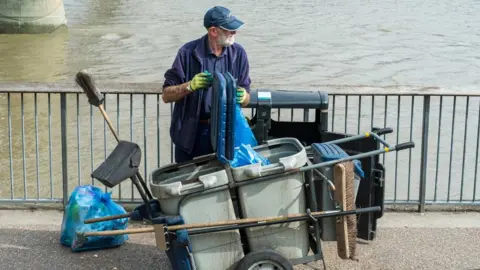Reality Check: Are these councils defying the cuts?
 Alamy
AlamyCouncils are in trouble - this much we know. They are cutting services, spending more than they planned and dipping into their rainy-day funds.
Perhaps the more pertinent question is not which councils are facing financial problems but are any managing to buck the trend.
Pretty much no local authority in Britain has escaped the cuts. The only councils not to have made any since 2010 are the City of London and the Isles of Scilly, which have very small populations.
But some have made smaller cuts than others.
Seven local authority areas reduced total service spending by more than 40%, while nine councils in England have reduced their spending on local services by less than 10% since 2009-10.
All the deepest-cutting councils are in England, as Scotland and Wales - where the average cut was 11% and 12% respectively - have used their devolved powers to protect councils to a greater extent.
The context
Looking at cuts in isolation doesn't give you the full picture, though.
Councils get their money mainly from a grant from central government (which is being phased out), council tax and taxes collected from local businesses. Poorer councils are less able to raise taxes and more reliant on government grants.
Since they can't make an overall loss or overspend one year and make it up later like companies can, councils can essentially balance their budget in one of three ways:
- Make more money (through council tax, business rates and development projects)
- Spend less (by cutting services or delivering them more efficiently)
- Draw on their reserves - the money set aside for a rainy day
But their ability to do each of these things depends on what type of council they are, where, and the demographics of their local population.
1. Raise more
For example, councils' ability to raise more money depends on how rich or poor their population is as well as how urban or rural.
In wealthier areas, there are more people paying council tax and more valuable properties.
It also means demand for council-funded services may be lower as, for example, more people pay for their own social care.
And cities, even if they have areas of deprivation, will generally also be able to attract more businesses from which they can raise taxes.
They may also find it easier to attract interest from developers to build houses (providing more council tax) and other developments such as hotels or shopping centres (which will have to pay business rates or in which councils can invest).

The central urban council
While the London Borough of Southwark has areas of significant deprivation, part of the borough also contains a major central London business district.
The council has raised an additional £16m a year in taxes, through the development of new homes and businesses, including the Shard.
Since 2013, about 7,500 new homes have been built, of which 20% are for social rent.
As a result of the extra tax take, the council has not had to close any libraries, has retained most of its children's centres, and its youth offending service goes above and beyond the statutory minimum, according to Labour councillor Victoria Mills.
It has also been able to invest in preventative public health services, including providing free gym membership for all Southwark residents.

It's not only in the capital that councils are finding ways to raise money from their local attractions, though.
 Getty Images
Getty Images
The deprived council doing things differently
Blackpool is among the poorest areas in the country. It has a relatively low council tax take and high demand.
But nevertheless, the council has managed to maintain key services - by doing things a bit differently.
It saved money by becoming the first council to be granted a water self-supply licence and buy its water directly from the wholesaler.
And, in 2010, the council bought a number of local attractions, including Blackpool Tower, as a way of making money and driving regeneration.
It also bought Blackpool Airport, in 2017, creating jobs, bringing in business rates and adding £374m to the local economy, according to a council official.

2. Spend less
When it comes to spending less, county councils have found it harder to make cuts, partly because of the types of services they provide. And it's these councils that are now sounding the alarm.
While some parts of the country have unitary authorities that deliver all council services, some are arranged in two "tiers" - a county council at the top and a district or borough council underneath.
Unlike district and borough councils, unitary and county councils are responsible for providing adult social care and children's services. These services are not only expensive but have lots of legal obligations attached to them.
So, a district council can save money by moving from weekly to fortnightly bin collection.
A county council, on the other hand, can't, for example, cut back social-worker visits to a child on a protection plan - it could be illegal, not to mention incredibly risky.
Simply looking at how councils' spending has changed over the years doesn't factor in the rise in demand that makes delivering services more expensive.
And, again, demand varies around the country. For example, the number of children per every 10,000 who are being cared for by a local authority ranges from 23 in Richmond-upon-Thames to 185 in Blackpool.
 Getty Images
Getty Images
The affluent district council
Sevenoaks has managed to become entirely self-sufficient, raising the money it needs to balance the books without relying on any grant money from central government.
Although it has cut a third of its spending since 2010, it has kept pretty much all of its services running.
This has been an easier ask than for some councils though - the reason it was included in the pilot of 15 councils to receive no government grant this year was it relied far less on it than many already.
As an affluent area with valuable properties, it is more able to raise money through council tax and business rates.
Perhaps most crucially, though, Sevenoaks is a district council. That means it doesn't have responsibility for the most expensive services - adult social care and children's services.

3. Reserves
Making fewer cuts is not necessarily a sign that a council is in better financial health - it may be that it is not getting to grips with the cuts it needs to make in order to become sustainable.
Some county councils, such as Somerset, are beginning to use their reserves to keep services running - the pot of money designed to buffer them against unexpected cuts or financial shocks.
In Northamptonshire - which ran out of reserves - although this was far from the only problem, the crisis was also partly driven by an unexpected rise in spending on children services.
It suddenly found itself looking after a number of unaccompanied asylum-seeking children who were being left at lorry stops off the M1, A45 and A43, within the council's boundaries.
Councils with reserves worth 5% of their annual spending or less should be a cause for concern, according to Prof Tony Travers, at the London School of Economics.
While on average councils in England hold reserves worth 32% of their annual spending, there are eight councils with reserves worth 5% or less, and 33 with reserves worth 10% or less of their total annual budget.



